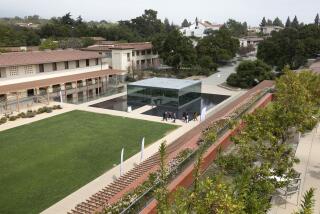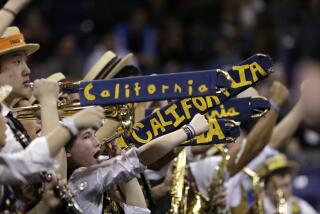What’s in a University Name? For Chapman, It’s Status
ORANGE — Forget Chapman College. The Board of Trustees voted Monday to replace that name with a more prestigious title: Chapman University.
What’s in a name? For starters, the public will be less likely to confuse the 130-year-old Christian liberal arts college with the numerous two-year community colleges in Southern California, say Chapman officials.
For another, international students won’t be put off by the title of college , which in many countries is synonymous with high school.
Lastly, university status is a better indicator of the master’s degree programs offered at Chapman. About 600 of Chapman’s 2,200 students are seeking graduate degrees or are in certificate programs.
“Our educational format actually is one of a university,” said George Argyros, chairman of the college’s Board of Trustees, who approved the change along with 25 other trustees at Monday’s meeting on campus.
“We have always hesitated using the word university because for many of us, it had the perception of being large. And we are not a large university,” Argyros said. “We don’t intend to become a massive university of the size of, say, a University of Southern California. We hope that in time, we will grow to a total enrollment of, say, 3,000 students. That would be enough for us. We wouldn’t want to be much larger than that.”
The university title can be had for the price of a $15 to $20 application fee paid to the state. No new accreditation is needed “because the Western Assn. of Schools and Colleges does not consider it a substantive change,” Chapman President Allen E. Koenig said.
The name change was just one of 19 items voted on as part of the college’s “action plan” for the next five years. The board, however, did not vote on the controversial strategic plan, which generated widespread faculty and student outrage when Koenig introduced it earlier this year.
The original plan called for a reorganization of the college so that liberal arts and humanities would no longer be at the core of the curriculum. It also called for establishment of new specialty schools on campus and a 20% cut in faculty within 1 1/2 years. Faculty opponents charged that Koenig was trying to move away from a strong liberal arts undergraduate program to a trade-school curriculum.
Amid the furor, Koenig agreed to turn it over to the Faculty Planning Committee for revisions. In the end, under the “consensus plan” accepted by the president, faculty cutbacks will be limited to those who retire or find other jobs over the next five years.
More important to many professors is that the reorganized college will have a school of arts and sciences at its core, even as the institution grows into an increasingly specialized mid-size university.
The so-called action plan also calls for raising enrollment in graduate programs, summer school and other special course offerings, as well as to increase the college’s marketing and public relations efforts.
The reorganization plan is part of Koenig’s efforts to help Chapman hang onto its share of the dwindling pool of college students and compete against lower-cost public universities and colleges in the area. Until last week, applications for the fall semester were down significantly. Koenig declined to discuss numbers or percentages but said applications began to come in greater numbers last week.
Another way Chapman hopes to bolster enrollment is to target returning students who seek additional degrees or training in certain specialties, hence the emphasis on training centers. On Monday, trustees approved creation of the Center for International Studies.
Koenig said trustees made a special effort to praise faculty for their hard work in developing the final draft of the college’s five-year game plan. Faculty generally seemed pleased after Monday’s meeting.
“I’m happy about it,” faculty chairman Arthur Blaser said of the name-change decision. “I think we’ll be able to present ourselves as the kind of institution that appeals to a lot of people, while retaining the sense of a caring community that has been part of Chapman as Chapman College. . . . There may be a greater awareness of the multifaceted nature of Chapman.”
Koenig cautioned that the school won’t change letter heads right away, even though they will apply for the change as soon as possible. To avoid confusing potential students during this recruitment season, he said, they will wait until new students are safely enrolled next fall before Chapman College becomes a name in the past.
More to Read
Sign up for Essential California
The most important California stories and recommendations in your inbox every morning.
You may occasionally receive promotional content from the Los Angeles Times.










